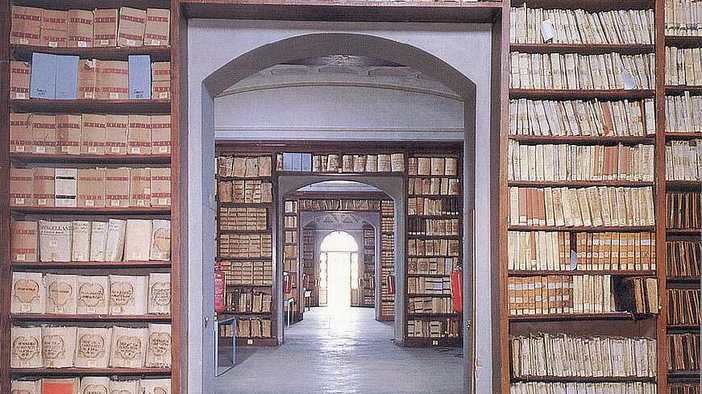Vatikan arşivleri, Ermeni Soykırımı’na ışık tutuyor


Cizvit rahip Georges-Henry Ruyssen tarafından hazırlanan ve 21 Mart’ta yayımlanan dört ciltlik belgelerin bir özeti olan habere göre, Mart ayının sonunda tamamı yayımlanacak olan arşiv, 19. yüzyılın sonundan 20. yüzyılın ortasına kadar ‘Ermeni meselesi’ne dair belgeleri içeriyor. Birçoğu Doğu Kiliseleri Senatosu’nun arşivine ait olan belgeler, papaların Osmanlı sultanlarına yazdıkları mektupları, Vatikan Dışişleri Temsilciliği ve kilisenin diğer yönetim departmanlarına ait belgeleri, misyonerlerin yazığı raporları, Ermeni patrikleri ve din adamlarından gelen mektupları ve kiliseye gelen tanıklıkları içeriyor.
Çoğu ilk kez yayımlanan belgelerden en önemlileri, Papa XV. Benedict’in Osmanlı Sultanı V. Mehmed Reşad’a yazdığı iki mektup. 10 Eylül 1915 tarihli mektupta, Sultan’ın Ermenilere yönelen şiddet eylemlerine yönelik tavır almasını isteyen XV. Benedict, 12 Mart 1918 tarihli mektubunda ise, Sultan’dan Ermenilerle ilgili yardım çalışmalarına kolaylık sağlamasını istiyor. Dergi, bu mektupların, olaylardan her daim haberdar edilen Vatikan’ın katliamlar karşısında pasif kalmadığını, aksine, gerçek anlamda çaba sarf ettiğinin ispatı olduğunu vurguluyor. Derginin haberine göre, XV. Benedict, o dönem bu kitlesel suça ses çıkaran tek siyasi ve dinî liderdi.
Belgelere göre, Vatikan’ın diplomatik girişimleri, bununla da sınırlı değil. 1917’de Cemal Paşa tarafından Suriye’de idama mahkûm edilen 60 Ermeni’nin serbest bırakılması için araya giren Vatikan, 1921 yılında Kardinal Pietro Gasparri aracılığıyla Mustafa Kemal ile görüşerek, soykırımdan kurtulan Hıristiyanların can ve mal güvenliğinin korunmasını talep ediyor.
Yayımlanan belgeler, Vatikan’ın diplomatik girişimlerin yanı sıra, soykırımdan kurtulanlara yönelik yardım çalışmaları yürüttüğünü de ortaya koyuyor. Dergi, o dönemde Kızıl Haç ve Yakındoğu İanesi (Near East Relief) dışında, diğer uluslararası insani kuruluşların Ermenilere yardım sağlamadığını ileri sürerken, Vatikan’ın maddi yardımları sürekli kıldığını belirtiyor. Bu yardımlar çerçevesinde, bölgede ‘her dinî inançtan yetime açık’ birçok yetimhane kurulurken, Ermeni yetim kızlarının ayrıca Roma yakınlarındaki Castel Gandolfo Apostolik Kilisesi’ndeki yetimhanede barınmaları sağlanıyor.
Belgelerin yayımlanmasının yanı sıra, bu yıl, Papa Francis, Ermeni Soykırımı’nda hayatını kaybedenler adına 12 Nisan’da St. Peter Bazilikası’nda bir ayin yönetecek. Ünlü Ermeni sanatçı Charles Aznavour’un soykırımın 100. yılı anısına Vatikan’da konser vermesi de planlanıyor.
Başepiskopos Bonetti, soykırımın öncesini anlatıyor
Arşivlerde yer alan bir diğer önemli belge de, 1887-1904 tarihleri arasında İstanbul’da bulunan Başepiskopos Augusto Bonetti’nin Vatikan’a gönderdiği raporlar. Bu raporlarda, 19. yüzyılın sonunda gündemde olan ‘Ermeni meselesi’nin Avrupalı güçler tarafından adım adım unutulduğu belirtilirken, bu durumun sebebi olarak, Avrupa diplomasisinin “sonucu ne olursa olsun Osmanlı İmparatorluğu’nun bütünlüğünü korumak için çalışmasını” gösteriyor. Başepiskopos Bonetti, Fransa ve Rusya’nın ‘Türkiye’nin bütünlüğünü korumayı hedeflediğini yazıyor. Bonetti’ye göre, Fransa, bölgeye büyük yatırımlar yaptığı için bu tavrı takınıyor. Rusya, Uzakdoğu politikasına odaklanmak için Türkiye’yle ilişkilerde etkisiz kalıyor. Almanya’nın ise maddi çıkarları uğruna, özellikle Türkler ile Yunanlar arasındaki savaşın devam etmesinden yana bir tavır takındığını yazan Bonetti, İngiltere’nin de Türkiye’ye yönelik önemli siyasi çıkarları olduğunu belirtiyor.
‘Vatikan belgeleri, soykırım çalışmalarına yeni bir boyut katacak’
Yektan Türkyılmaz (Antropolog, Zentrum Moderner Orient)Vatikan’ın Ermeni sorunu ve soykırımı üzerine olan belgelerini düzenlemesi ve bunu araştırmacıların kullanımına açması, bu alandaki çalışmalara şüphesiz çok önemli bir yeni boyut, taze bakış katacaktır. Fakat bu arşivin bizim açımızdan önemli olmasını sağlayacak birkaç temel sebep var. Birincisi Anadolu’da ve Suriye’de Katolik misyonlar, Protestan misyonlardan çok daha önce kuruluyorlar, hatta 17. yüzyıldan beri varlar. Dolayısıyla, bu malzeme, Katolik kurumların faaliyet gösterdikleri bölgelerdeki Ermeni grupların değişen durumları hakkında daha geniş bir perspektif sunacaktır. Öte yandan, Ankara, Erzurum, Van, Harput, Halep, Diyarbekir gibi birçok vilayette Ermeni Katolikleri, diğer Ermeni cemaatlerine, bazen rakip ve çokça da onlardan oldukça kopuk ve kendi içlerine kapalı yaşadılar. Dolayısıyla, bu gruplar hakkında bildiklerimiz çok daha sınırlı. Diğer bir nokta ise birçok Katolik misyonlar, soykırım sırasında yerlerinde kalabildiler. Ve duruma hem müdahale etmeye çalıştılar, hem de katliamların ve cemaatlerin yok edilmesinin birinci el tanıkları oldular. Bunların dokümantasyonunun ulaşılabilir olması, Osmanlı Ermeni cemaatlerinin imhasına dair bildiklerimizi temelden değiştirmese de, önemli bir katman ekleyeceği kesin. Mesela bir örnek olarak ilk aklıma gelen, Trabzon Katolik Başepiskoposu Nazlıyan’ın anıları, çok önemli bir kaynaktır. Onunki dahil, Katolik din görevlisinin kişisel belgelerini içeren koleksiyonlar, gerçekten paha biçilemez önemde olacaktır. Son olarak, soykırım esnasında Katolik Ermeniler, birçok yerde daha farklı muamele gördüler; buna en temel örnek, belki de Ankara Vilayeti Ermenileridir. Ayrıca bir diğer kritik yer ise, Ermeni nüfusunun esasen Katoliklerden oluştuğu Mardin. Vatikan belgelerinin bu yerler için büyük ölçüde yeni ufuklar açacak malzemeler sunacağını düşünüyorum. Ayrıca, yavaş yavaş ilgi odağı hâline gelen failler dışındaki, özellikle (yabancı) devlet aktörlerinin Ermeni Soykırımı’nda sorumlulukları konusundaki tartışmalara da büyük katkı sunacağı kesin. Avusturya-Macaristan İmparatorluğu ve Almanya’nın Katolik temsilcilerinin girişimlerini ve neden müdahil olup olmadıkları hususunda da oldukça aydınlatıcı olacak bu belgeler de, umuyorum ki, yayımlanan malzemelere dahil olur.


